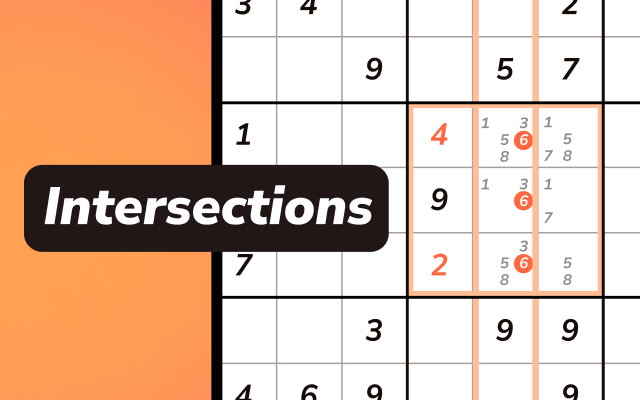Sudoku Basics: Intersections

Playing a Sudoku puzzle is fun, but learning how to solve it more efficiently and effectively is even more fun. Once you’ve grasped the rules and relevant terms of a Sudoku game, it’s time for you to start progressing and ramping up the difficulty of your efforts to become a more skilled Sudoku player. Aside from scanning for digits, another essential skill you should learn as a beginner in the Sudoku world is solving the grid using intersecting rows and columns.
Most commonly known as intersections, this puzzle technique makes full use of basic skills and logic, allowing most new players to fill in many cells in Sudoku puzzles that scanning and counting can’t. How does it work in the game? Is it crucial to learn to play and enjoy a puzzle?
Continue reading to learn more useful Sudoku tips for the day!
What Are Intersections?
Intersections are very useful for beginner Sudoku players looking to fill in cells that can’t be solved with other basic techniques. They’re named like that because they have multiple cells that intersect with each other, may it be in a row or a column. This is one of the most common elimination techniques a beginner can learn within the game and works very well on easy Sudoku puzzles when used with other skills like counting and scanning.
Intersections eliminate cells by having rows and columns that coincide with a target box. Since the rules of a Sudoku game state that you can’t repeat a number in a row, column or box, the areas within these intersections can no longer be used to fill in that specific number. Those that are not within the intersections can be used instead, allowing players to fill the grid better and faster.
Ideally, it’s best to isolate one cell with this technique, but it’s also often that you’ll end up with two or three open cells with it, which most beginners then fill through trial and error after or use candidate notation (another Sudoku puzzle technique for another discussion).
How Does It Work in Free Sudoku Puzzles?
Let’s start with finding a box that does not contain the digit we’re looking for. To make it simple and easy to remember, it’s always recommended to start looking for numbers 1 to 9 within these boxes. For now, we’ll choose the number 1, and we’ll be doing that with this example:
As you can see, all the other boxes have the number 1 in their cells, except for box 4. This is where we’ll use the intersections technique. Since there is no number 1 in box 4, look at the other boxes that intersect with box 4 horizontally and vertically. If your answers are boxes 1, 5, 6 and 7, you are correct!
Now, look at the rows and columns of these boxes that intersect with box 4 and find their number 1s. These are cells r3c3, r4c8, r6c4 and r7c2.
You can then visualize a line (or you can choose to use your finger or draw it if you're having difficulty imagining it) across those rows and columns with the number 1, and have them all go towards box 4. We now have the intersections to work with and we can proceed with elimination.
Elimination Using Intersections
Using the rows and columns that have the number 1 and intersect with box 4, we can determine or eliminate which cells we can’t put the number 1 for box 4. And we’ll conclude that only r5c1 is the possible place we can put the digit 1 for this box.
Congratulations! You’ve just used the intersections technique! Quite easy, right?
We’ll do another one, and just like we told you before, it’s best to do this process sequentially. So all boxes have the number 1, then let’s scan if they all have the number 2. And in our sample grid, there are a lot of boxes missing the number 2 in them, so how will this work?
Intersections Work On Multiple Boxes With Missing Numbers
In our sample Sudoku grid, there are only three boxes that have the number 2 in them. Let’s use intersections to solve one box, and it’s best to pick a box with the most amount of intersecting boxes with the number 2 in them.
Let’s choose box 8 since boxes 2 and 7 have 2s that intersect with it. Like before, imagine or draw a line across the rows and columns that intersect with our target box. Now that we’ve eliminated the cells we can’t put the 2 on, we’re left with the ones we can use. Since the other cells in box 8 are already filled in with other numbers, we’re left with just one logical choice, and that’s to fill in cell r7c5.
Congratulations, you’ve filled another box using the intersections technique!
Limitations of Intersections and Going Beyond
You can continue filling in other boxes and cells in an easy Sudoku puzzle using this technique, but you will most likely end up with boxes with two or three open cells even after using intersections.
When this happens, it’s best to leave these boxes alone until you fill up other boxes enough to the point you can fill them with the same technique again, perform trial and error without putting the rest of the grid at risk, or do the best possible action, use candidate notations (which we will explore in another article).
Additionally, since this technique relies heavily on givens, it doesn't work as well in medium Sudoku puzzles and harder difficulties but is an important skill to learn to understand other advanced techniques. But at the end of the day, learning how to solve more Sudoku sets with increasing difficulty will make you a better overall Sudoku player.